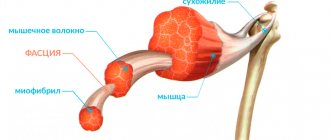Multiple sclerosis
– a chronic disease of the spinal cord and brain caused by disturbances in the functioning of the immune system. Foci of the disease are located in various parts of the nervous system and have the appearance of a plaque of scar tissue. The size of such defects can be microscopic or large - several centimeters.
The disease affects more often young people, develops mainly in women under 40 years of age, suffering from a lack of vitamin D, and develops less often in men.
Causes of the disease
The main reason is disruption of the immune system. Normally, the human brain is protected by a barrier that keeps microorganisms out. When suffering from multiple sclerosis, lymphocytes penetrate into the brain and do not eliminate foreign bodies, but attack the body’s own cells. The resulting antibodies destroy the membrane of nerve cells and contribute to the development of the inflammatory process. As a result, a scar is formed. Plaques on nerve fibers change the conduction of impulses to organs and the brain cannot control the actions of the body, the efficiency of controlling processes is significantly reduced.
Therapy at home
When treating and caring at home, the patient requires professional help and constant diagnosis of the disease. This will make it possible to monitor the patient’s condition and not miss the need for urgent therapeutic intervention. Therefore, high-quality treatment and care at home will not work. What can be offered in such a situation is only care without treatment or special measures.
Our boarding house with a medical focus invites you to leave useless activities and turn to us for help. Our specialists will conduct a full diagnosis of the ward and talk about his condition at this hour, advise the correct measures of care or full service in our boarding house.
Initial symptoms of the disease
The peculiarity of the symptomatology is its individuality. Symptoms of the disease can differ significantly not only from person to person, but also from one and the same person over time, symptoms can change. As a result of an increase in the number of sclerotic plaques, the signs of multiple sclerosis are complemented.
Signs of the disease are:
- Pain in muscle spasms, increased muscle stiffness;
- Loss of bowel and bladder control, constipation and urinary retention;
- Changes in sexual function;
- The appearance of reflexes that are not characteristic of healthy people can only be determined by a neurologist;
- Performing physical activities is accompanied by high fatigue;
- Partial paralysis of the limbs and cranial nerves is observed, voluntary movements are difficult;
- Oscillatory movements of the eyeballs, decreased vision, and double images appear;
- Intelligence decreases, behavior is disrupted;
- Involuntary movements and tremors appear;
- Coordination deteriorates, speech is impaired;
- The gait becomes unsteady;
- Neuroses appear, a person loses emotional stability, he alternates between euphoria and depression;
- Paralysis of any part of the body is possible.
After taking a hot bath and under the influence of a hot climate, the patient's condition worsens. It is recommended to avoid overheating.
In addition to medications, there is something that can be done to help such patients. Relatives and family members can do something.
We need very serious support from family or loved ones, a non-conflict home situation. Secondly, if necessary, if there is a disability group, the patient must be provided with all social conditions and technical means of rehabilitation
It is very important that he undergoes rehabilitation techniques and takes medications in a timely manner. It is necessary for the family to become a big “reminder” of what he should watch out for, to provide emotional support
A certain diet, rich in vitamins, with a compensated amount of proteins and long-chain fatty acids, a certain daily routine, water procedures, physiotherapy - all this must be done.
It is necessary for these people to work with non-profit organizations, which exist in almost every region, so that they work with multiple sclerosis centers, which exist in every two of the three regions of Russia. So that they go to the websites of the All-Russian Organization of Patients with Multiple Sclerosis (https://ms2002.ru) and other projects that exist for these patients, where advice is given and rules of life that help patients are described. We need people to receive information and follow it.
Just a year ago my life was completely different. The first year of my master's degree was finishing, I was working a little and did not strive to settle down in this life. It seemed to me that there was plenty of time, prospects, opportunities ahead and there was no reason to get out of my usual comfort zone. During a medical examination at the military registration and enlistment office, at an appointment with a neurologist, I mentioned that sometimes I am bothered by numbness in my hands, migraines and episodes of blurred vision. On the advice of a doctor, I went to a local clinic, where I received a referral for an MRI. After the examination, I first came across the term demyelinating disease of the central nervous system - multiple sclerosis. At that time, I had little idea what this could even mean.
A disease with a thousand faces
I only recently began to understand what multiple sclerosis is. Until that moment, I tried not to think about the possible consequences: the disease seemed something distant and impossible. I clearly remember the moment when I realized that this disease would now be with me for the rest of my life. It was hard. It's hard to accept that there's a very real prospect of ending up in a wheelchair when you're young and have a lot of plans for your life. But these are new difficulties that had to be accepted and lived with.
Not without wandering to doctors, endless tests and research. During this time, I underwent an MRI three times and heard a lot of assumptions from doctors - up to the suspicion of borreliosis, which allegedly arose from an old tick bite. Now I understand that since the state provides patients with drugs for the treatment of multiple sclerosis, doctors are playing it safe and are in no hurry to make a diagnosis. Such delays in the process and bureaucracy greatly tire the patient himself, and most importantly, alienate him from treatment. So much time had passed from the first suspicion of multiple sclerosis to the diagnosis that I had already come to terms with the idea that I was sick. I must say that I did not hear clear recommendations from doctors even after it became obvious that I had multiple sclerosis. I was advised to be less nervous and move to the south so as not to burden my immune system with colds and ARVI.
Diagnostics
In young people with intermittent symptoms, the disease is easily diagnosed. It is more difficult to diagnose with mildly expressed disorders and no signs of damage to the nervous system. Perhaps the first signs of the disease appeared long before going to the doctor, but the patient forgot about them or did not connect them with real manifestations.
Diagnosis of the disease is based on characteristic manifestations:
The first step towards making a diagnosis is a thorough collection of anamnesis and analysis of the information received, a thorough examination and interview of the patient.
The following activities are important:
- Physical examination by a neurologist;
- Blood chemistry;
- Cerebrospinal fluid puncture.
A timely, correct diagnosis contributes to a long, active, fulfilling life for the patient. It is important to immediately consult a doctor when the first symptoms appear.
To diagnose the disease, it is important to consider the following factors:
- The duration of the appearance of signs of multiple sclerosis lasting more than a day with an interval of a month;
- Identification of lesions on MRI.
Additional examination can be carried out to clarify the diagnosis. This could be electromyography or an immunological blood test. Currently, new diagnostic methods make it possible to detect the disease even in children.
Multiple sclerosis (MS) is a progressive autoimmune disease that affects the central and peripheral nervous system. The protective covering of nerve cells (myelin) is damaged, leading to decreased functionality of the brain and spinal cord. Any neurological symptom can be caused by multiple sclerosis . This is manifested by various neurological symptoms: loss of visual acuity, impaired coordination of movements, emotional instability, forgetfulness, insomnia.
Pathology specific relationship with age. The disease manifests itself at the age of 20, 40 or 50 with various symptoms that are also inherent in other diseases of the nervous system. Negative signs may disappear for several months or for a longer period, which allows patients to forget about the problem. In the most unfavorable cases (which is rare), the disease develops rapidly, the deterioration of well-being progresses over several weeks, and the negative changes are already irreversible.
Mechanism of action of the disease
Sclerotic changes are the process of replacing healthy tissue ( muscle, nervous and others) with connective tissue, as occurs with scarring. The formation of such a “patch” occurs in inflamed or injured areas. A good example is the formation of a rough scar after myocardial infarction.
Sclerotic lesions in multiple sclerosis , formed as a result of damage to myelin, look like compactions in the form of plaques, the size of which can reach several centimeters. Since, as the pathological process progresses, sclerotic compactions appear in different places of the central nervous system, the disease is called “disseminated,” that is, affecting the entire body.
Risk factors
The causes of the development of autoimmune disease have not been precisely established, but factors have been proven that increase the likelihood of the occurrence of pathology:
- young age (20–40 years);
- heredity (if close relatives have been diagnosed with the disease, the likelihood of getting sick increases);
- female gender (women get sick three times more often than men with MS with an undulating course);
- some viral agents can trigger the disease (Epstein-Barr virus, which causes mononucleosis);
- race (Europeans are in the highest risk group);
- vitamin D deficiency;
- smoking.
Residents of the northern regions get sick somewhat more often than those living in the south, although in sunny areas there has recently been an increase in the incidence of MS, as well as other immune pathologies.
Types of multiple sclerosis
The disease is characterized by the occurrence of persistent changes in parts of the brain and spinal cord, and an unpredictable frequency of alternating periods of remission and relapse.
Relapsing-remitting sclerosis is the most common form of the disease (the diagnosis is made in 8 out of 10 cases). The duration of the remission period ranges from one year to several decades, with the period of the first remission being the longest.
The secondary progressive form occurs in approximately 15% of patients several years after diagnosis. Symptoms become more pronounced with each period of exacerbation, and during remission, signs of the disease partially persist. The prognosis for the course of the disease is negative. The patient's health condition worsens with each relapse.
Primary progressive sclerosis is a rare and complex form of the disease, characterized by a gradual (or abrupt) increase in symptoms. There are practically no periods of sustained improvement in well-being (remission).
MS diagnosis is not a death sentence
Multiple sclerosis is a complex, difficult to treat disease, which currently cannot be completely eliminated. However, medical science has made significant strides in achieving stability in patients with this diagnosis. People work fully, relax and even participate in sports competitions.
Success in achieving remission depends on the stage at which the patient went to the doctor and how correctly the treatment regimen was drawn up. An individual approach is of great importance in consolidating positive results. The doctor takes into account the patient’s age, health status, time of diagnosis and the form of MS.
As already mentioned, primary recurrent disease is the most difficult to treat, but the use of modern therapy methods can improve well-being, prevent disability, and maintain a stable condition of the patient.
Symptoms of MS
The first signs appear more often at a young age, from 20 to 45 years. There can be from one to several symptoms, the frequency of their recurrence cannot be systematized. Loss of coordination, blurred vision, numbness of the limbs, and decreased intellectual function are the most common symptoms in men and women.
Optic nerve damage, an early sign of MS, results in double vision, color blindness, pain, and involuntary eye movements.
Fluctuations in body temperature (lowering and rising) also indicate the development of the disease, although short-term fever is often associated with a cold or viral diseases.
Sudden pain when tilting the head, reminiscent of an electric shock (Lhermitte's sign) is a reliable sign of MS if this phenomenon occurs frequently.
Muscle spasms and pain in the legs occur in different forms and stages of the disease. Sudden pain while walking causes the patient to limp, so the gait of people with MS often appears unnatural.
Impaired motor coordination is associated with pathological changes in the cerebellum. Depending on the nature of the disease, brain dysfunctions can be chronic or acute (occurring periodically). Practical experience proves that if the cerebellum is damaged in the initial stage of the disease, the prognosis for its course worsens.
Most patients experience involuntary twitching of the limbs and facial expression disturbances. Tremor is a consequence of unstable functioning of the cerebellum.
Loss of control over physiological processes occurs in 68% of patients (equally in men and women). Urinary and bowel incontinence, loss of sexual desire, impotence, and spastic pain in the pelvic area are caused by damage to the spinal nerves. With a spastic bladder, frequent and intermittent urination and incomplete emptying of the bladder are observed. Pathologies developing in the urinary system lead to a number of negative consequences:
- increasing weakness;
- frequent urinary tract infections;
- formation of kidney stones;
- decreased social activity;
- psychological discomfort.
Emotional disorders are expressed by tearfulness, prolonged depression, panic attacks, obsessive states, panic attacks, constant anxiety and restlessness. Frequent changes in mood, from laughter to crying, are due to a lack of myelin.
Mood instability is one of the prominent symptoms of multiple sclerosis. Psychological discomfort and mental suffering of the patient are the cause of family breakdown and career destruction. Medical care within the framework of an individual treatment program plays a significant role in improving the quality of life.
Diagnostics
It is difficult to diagnose the disease at an early stage, since the symptoms are common to many neurological pathologies. The most informative methods are:
- MRI scan with a contrast agent (the images clearly show active and inactive lesions of the brain);
- examination of the cerebrospinal fluid (puncture) to detect antibodies and areas of inflammation (the method allows for clear differentiation with neurological diseases that have similar symptoms);
- measurement of electrical activity of nerve fibers (method of recording evoked potentials);
- ophthalmological examination (the nature of damage to the organs of vision is determined).
Comprehensive studies will make it possible to make a reliable and accurate diagnosis, determine the nature and stage of multiple sclerosis, with MRI being the main diagnostic method.
Treatment of MS in young people
Treatment of multiple sclerosis includes three areas:
- relief of exacerbations;
- slowing down the development of the disease;
- elimination of negative symptoms.
Therapeutic procedures used in modern neurological practice are diverse and varied, which makes it possible to achieve stable remission (including when diagnosing complex forms of the disease).
In the early stages, therapy is aimed at preventing disability. It is necessary to slow down the destruction of the nervous system and develop a positive attitude in the patient. Belief in the success of treatment plays a huge role in the onset of stabilization and significantly increases the effectiveness of medical procedures.
If disability has occurred (the patient cannot move independently), medications and procedures are prescribed to improve the quality of life, relieve pain, relieve nervous tension, and eliminate depression.
First-line drugs (FLT) are beta interferons. The effectiveness of the course of treatment after taking medications is assessed every three months.
The second group of drugs are monoclonal antibodies that prevent the penetration of immune cells into the structures of the central nervous system.
Symptomatic drugs are prescribed based on the manifesting signs of the disease. This line includes antidepressants, vitamin complexes, and drugs that stimulate metabolic processes.
Physiotherapeutic procedures for multiple sclerosis are used in cases where patients cannot move independently. Physiotherapy allows you to maintain preserved motor functions and reduce the intensity of pain in the pelvic area.
It is important to use aids for independent movement to avoid congestion in the tissues and complete muscle atrophy. Practical experience proves that correctly chosen physiotherapeutic procedures significantly improve the patient’s overall well-being and partially relieve internal tension caused by anxiety and fear.
What should a patient know about multiple sclerosis?
The patient must understand that it is not yet possible to cure MS, but it is possible to live fully with this pathology. The life expectancy of healthy people and those diagnosed with MS does not differ significantly, except in rare cases of severe disease. It is important to follow all doctor’s instructions and under no circumstances exclude yourself from an active social environment. The human brain actively works when mastering new skills, gaining knowledge, training memory, and developing intellectual functions.
Physical education plays an equally important role in the onset of remission. Physical exercise should become the norm of life - as necessary as hygiene procedures. Exercise therapy, like physiotherapeutic procedures, is prescribed by a doctor as part of a personal treatment developed taking into account age, nature and type of disease.
Constant medical monitoring allows one to draw conclusions about the effectiveness of the applied therapy methods and make adjustments as treatment progresses. It is difficult for doctors to predict the nature of the development of pathology; each patient’s disease progresses differently. Sometimes the process slows down for many years, while medicine is constantly developing, which means that patients have a chance to get even more effective drugs or undergo treatment using new methods.
If you have neurological symptoms, sign up for an examination at the PROFMEDCENTER clinic in Voronezh by calling +7 (473) 202–1–200. The earlier the disease is detected, the higher the chances of successful treatment .
Treatment of multiple sclerosis
Today, no drugs have been created that completely stop the development of the disease and restore the body. The treatment uses alternating periods of exacerbation and remission. The following treatment strategies may be used:
- Purification of blood and reduction of inflammatory processes;
- Symptomatic treatment - antidepressants and certain therapeutic methods are prescribed;
- Specially developed medications are used to slow the progression of the disease, but there are no side effects.
Sick people are advised to:
- Periodic regular physical activity;
- a complete and balanced diet;
- Complete rest;
- Physiotherapeutic procedures and relaxation (meditation, yoga);
- Cool ambient temperature to prevent overheating of the body.
The disease occurs with alternating periods of exacerbation and remission with a significant weakening of symptoms. Properly selected treatment can make the period of remission long, and the duration of the period of exacerbation can be extremely shortened. The prognosis of the disease is not optimistic, but with timely diagnosis and proper treatment, patients can live for many years.
Prognosis and risks for MS
The prognosis depends on the stage at which the disease is detected, what its type is and the general resistance of the body. The following types of MS are distinguished:
- Benign - with this type, the intervals between attacks become faster, the myelin sheath has time to recover.
- Remitting course - in this case, periods of exacerbation can last several weeks, and recovery occurs through a long cycle.
- Primary progressive MS is characterized by the absence of clear symptoms of exacerbation, but leads to a gradual deterioration of the condition.
- Secondary progressive or chronic MS - initially occurs as a remitting type, but over time it steadily begins to progress.
- Progressive-remitting MS occurs with constant deterioration and periodic acute outbreaks of the disease.
- Multiple sclerosis gradually leads to the fact that a person cannot independently perform usual social activities, self-care and professional responsibilities.
Which group of disabilities the patient will receive depends on the nature of the disease. Thus, with benign MS, disability is not awarded, life expectancy remains at the same level.
With a relapsing course, life expectancy is reduced by 7 years; depending on the condition, the patient is assigned disability group 3.
Life expectancy - 40 years or more - is an extremely rare phenomenon, because in order to establish this fact, you need to find people who got sick back in the 70s of the 20th century.
Difficult. With a malignant course of MS, some die after 5-6 years, while the sluggish process allows a person to remain in an active working state for quite a long time.
Neurologist consultation
| Name of service | Price |
| Appointment (examination, consultation) with a neurologist with an academic degree of K.M.N. (academic title "associate professor"), primary | 2300 |
| Appointment (examination, consultation) with a neurologist with an academic degree of D.M.N. (academic title "professor") primary | 7500 |
| Primary appointment (examination, consultation) with a neurologist | 2000 |
| Repeated appointment (examination, consultation) with a neurologist | 1500 |









